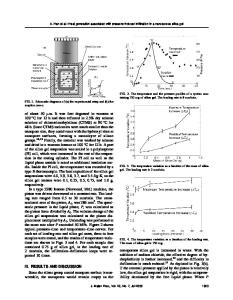Infiltration of C/SiC composites with silica sol-gel solutions: Part II. Infiltration under isostatic pressure and oxida
- PDF / 434,249 Bytes
- 7 Pages / 612 x 792 pts (letter) Page_size
- 1 Downloads / 290 Views
MATERIALS RESEARCH
Welcome
Comments
Help
Infiltration of C/SiC composites with silica sol-gel solutions: Part II. Infiltration under isostatic pressure and oxidation resistance Mario Aparicio and Alicia Dura´n Instituto de Cera´mica y Vidrio (CSIC), E-28500 Arganda del Rey, Madrid, Spain (Received 15 March 1999; accepted 30 August 1999)
An infiltration process that uses silica sol-gel solutions was developed to protect C/SiC composites against oxidation. The infiltration is assisted using isostatic pressure. Different process parameters including substrate porosity and solution concentration and viscosity were varied to optimize the infiltration effectiveness. Applied pressure enhances penetration of solutions, reducing the importance of viscosity, an important process variable for dipping infiltration. The effectiveness of the isostatic pressure infiltration method, evaluated through the total weight gains and pore-size distribution of infiltrated samples, is compared with results of dipping infiltration. The oxidation behavior of the infiltrated samples, was evaluated by stepwise oxidation test as well as isothermal tests at 1200 and 1600 °C. The infiltrated SiO2 protects the C/SiC substrate, reducing the burnoff rate of C fibers at low temperature and delaying the oxidation of SiC.
I. INTRODUCTION
Ceramic matrix composites, specifically SiC reinforced with C fibers, are candidates for high-temperature aerospace applications, and such materials are suitable for structural parts of reentry vehicles, because of their mechanical properties and chemical stability. However, processing leaves these materials with high final porosity, giving them poor oxidation resistance.1,2 Infiltration is one route to fill the porosity, thereby enhancing the mechanical properties and oxidation resistance. Our previous work developed a dipping infiltration process at room temperature and atmospheric pressure that used SiO2 sol-gel solutions.3 The results showed that many low-diameter pores were not accessible by pressureless infiltration. Spontaneous infiltration of a liquid into a porous body takes place when a liquid wets the solid. Otherwise, an external pressure is required to force the liquid into the pores. Delannay et al.4 reviewed wetting by molten metals. The wettability of a solid by a liquid is measured by its “contact angle” , related to the three surface tensions, ␥sg , ␥sl , and ␥lg , seen at the solid–gas, solid–liquid and liquid–gas interfaces, respectively, by the well-known equation (1) ␥lgcos ⳱ ␥sg − ␥sl . A liquid is said to wet a solid surface when cos > 0, i.e., when ␥sg > ␥sl. The driving force for wetting, Df , may thus be defined as Df ⳱ ␥sg − ␥sl .
(2)
J. Mater. Res., Vol. 14, No. 11, Nov 1999
http://journals.cambridge.org
Downloaded: 02 Apr 2015
When Df ⳱ ␥lg , ⳱ 0, and the liquid spreads spontaneously on the solid surface. The infiltration of a liquid into a solid network may be modeled assuming that the network consists of cylindrical capillaries into which the liquid penetrates. Consider
Data Loading...










